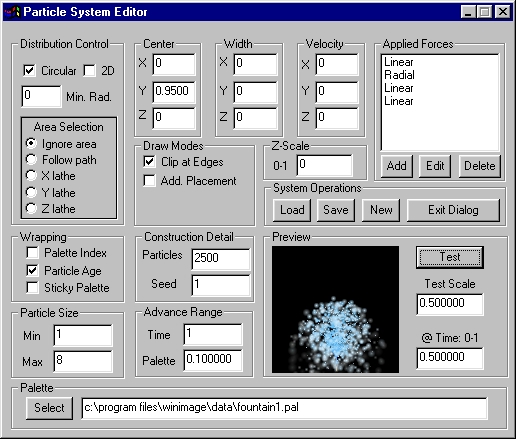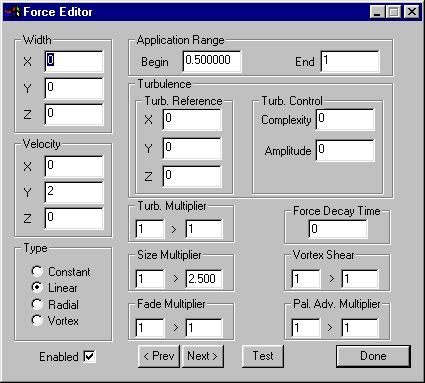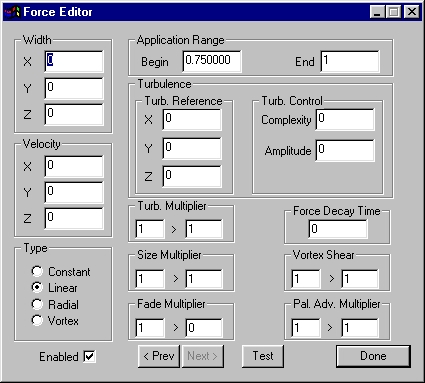| Quick Nav Bar | ||||||||
|---|---|---|---|---|---|---|---|---|
| << Previous | Contents |
Selection |
Op Index |
Parent | User Notes |
Index |
Glossary |
Next >> |

|
Particle Definition |
| Here we have 2500 particles, ranging in size from 1 to 8. No area selection sensitivity - so the particles start where they are distributed, and move where the forces send them. This system is very straightforward in this sense. You'll note that the center position is displaced; that's what gets the base of the fountain near the bottom of the image. Since the Time Advance is set to 1, the 2500 particles are evenly distributed along the time of the animation, so the entire fountain shape is active at all times. On the other hand, the Palette Advance is set to a small value, 0.1. This means that given where the particles are in time, they are also within .1 of where you'd expect them to be in pulling colors from the palette. That enforces the idea that the water only goes to the white colors towards the end of the cycle, and it also forces the stem to remain brown (see the palette colors below for more on that.) The definition is 3D, so the particles were formed as a sphere initially, though an infinitely tiny one. |
Force 1 |
| This force is taking the role of gravity, essentially. It provides a constant downward accelleration of -2 along the Y axis from time 0 to time 1, which is the entire span of the animation. It is also "carrying" a Size Multiplier of .5 to 1, which means that at time 0, the original size range which was 1 to 8, goes from .5 to 4. But under the influence of this force, by the end of the time span, the particles would range in size from 1 to 8; they smoothly grow from one size to the other under the influence of this multipler. That would be so if this was the only force that affected the particle size - but it's not. Force 3 does, also. They factor each other. |
Force 2 |
| This force is the one that causes the particles to expand out as they exit the imaginary nozzle. The force comes into play at time .25 (1/4 of the way into the time range) and ends by .6. The force decay time causes it to reach zero by time 1, because it was at time .6 when it stopped accellerating the particles - that leaves .4 remaining. That's what causes the expansion to slow down gradually, or to look at it another way, that's what causes the water to begin to fall straight with the "gravity" force, which you'll remember is constant over the entire system. |
Force 3 |
| This force comes into play at .5, and continues until time 1. This is an upwards force (See the Y is 2, exactly counteracting the "gravity" force?) It's carrying a size multiplier; so it grows the particles from where they were left by force 1 (heading for 1-8 by time 1) to reach a range of 2.5 to 20. These two size multipliers factor each other. There is no limit to the number of forces or the number of factorings... you can get pretty crazy if you need to! |
Force 4 |
| This last force begins at .75 and runs to time 1. You can see there are no velocity components, they're all set to zero. So what's the point? Well, this force is what we've taken to calling a "factor carrier". It carries a Fade from 1 (no fade) to 0 (completely faded out) that begins at .75 and ends at time one, the net effect of which is that the particles dissapear nice and easy, instead of "popping" away at time one when they are reset into the beginning of the animation (they move instantly to the base of the fountain at that time.) |
Palette |
|
You can see a little trick we pulled in this palette. If you look at the
animation, you'll see that the fountain is spraying from a stem or rod.
Well, really, the rod is part of the particle system, we just have the
radial size choked down hard for the amount of time it takes to get up
as high as the brown colors in the palette are in effect. Instant
tapered stem with a perfect match to the water (because it is the water!)
Other than that, you can see that the water turns whiter, the later in the time stream the color will be used. That's what a fountain does; the water mists out and reflects more light, losing it's own color in the process. Although water usually isn't blue - it’s more black than anything else, but we like the effect of the blue. Hey - it's a dyed fountain! Yeah, that's it! |
| Quick Nav Bar | ||||||||
|---|---|---|---|---|---|---|---|---|
| << Previous | Contents |
Selection |
Op Index |
Parent | User Notes |
Index |
Glossary |
Next >> |
| WinImages F/x Manual Version 7, Revision 5, Level A |